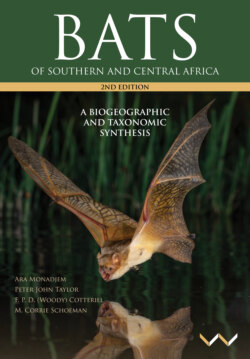Читать книгу Bats of Southern and Central Africa - Ara Monadjem - Страница 29
На сайте Литреса книга снята с продажи.
Specialised roost sites
ОглавлениеOpen structures, such as garages and outhouses, thatched game hides, culverts under roads and the eaves of buildings, are frequently used as night roosts (Monadjem et al. 2009). Many cave-dwelling bats carry their insect prey to such night roosts or feeding stations, which provide temporary shelter. These activities of night-roosting bats can often be located by the piles of discarded insect parts below their feeding spots.
Bats may also be found roosting in a variety of other situations. A most interesting example is the use of sunbird and weaver nests as the favoured diurnal roost sites for woolly bats of the genus Kerivoula (Roberts 1951, Oschadleus 2008).
Figure 20. Sandstone hills in the western Limpopo Valley provide daylight roosts for many crevice-roosting bats, such as Sauromys petrophilus (© F. P. D. Cotterill).
Some bats use artificial roosts such as bat houses (Tuttle 1997, Weier et al. 2019b). These may be most effective when used to relocate nuisance bat colonies from human dwellings, or to attract bats as potential biocontrol agents in agricultural monocultures and in ecotourism developments. Establishing such bat populations offers the opportunity to reduce the use of pesticides in controlling insect pests. However, the possible negative consequences of bat houses in natural ecosystems, where common species may be favoured over rare species, remain to be investigated.
